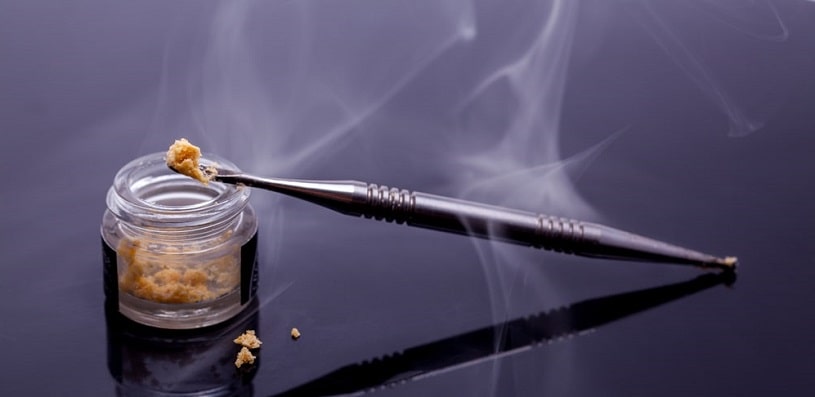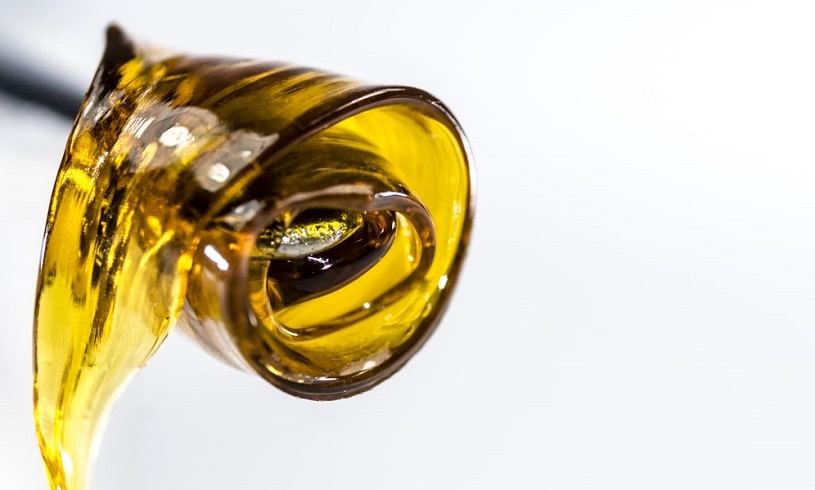For the past few years, the cannabis community has had a growing obsession with dabbing weed. This has become an increasingly popular method of weed consumption because it produces quick and strong effects. However, this method of use has raised serious concerns because of the potential environmental and health risks.
Table Of Contents:
If we look at history, marijuana wax use dates back to the 1970s when a small group of pot users first developed the technique. With the advent of superior marijuana concentrates and oil extraction methods in recent years, this dangerous activity has gained popularity among users, especially high school seniors and college students. Let’s find out more about what it means to dab weed and the dangers of this method of use.
How Does Dabbing Work?
Weed wax is made by extracting marijuana concentrates with a solvent such as butane. The concentrated butane hash oil (BHO) goes by many names, including honey oil, marijuana wax, and crumble. BHO contains between 50 and 90 percent THC, the main psychoactive component in cannabis (a typical joint contains between 5 and 20 percent). Dabbing refers to the process of vaporizing marijuana oil by placing it on a hot surface and inhaling the smoke.

This method of use produces rapid marijuana effects on the brain. However, there is a growing controversy surrounding the phenomenon. With the increasing popularity of special dab vaporizer pens, healthcare professionals have expressed concern about the potential health hazards of smoking marijuana concentrates, including dangers to the developing fetus. Experts have begun to raise awareness about the many dangers of this method.
Weed Dab Types
Marijuana dabs are a concentrated form of pot that can provide intense effects and superior medicinal benefits. In general, all dabs and concentrates are referred to as wax, but there are also other names depending on the kind of concentrate extraction.
Here Are Some Of the Different Types Of Weed Wax Dabs:
- Marijuana Shatter. This is a transparent, smooth, light-colored concentrate that resembles a glass sheet and shatters when dropped.
- Scissor. This type of concentrate is collected from the scissors used to cut the leaves and the hands of workers who handle the plants. The sticky extract has a high concentration of cannabinoids
- Dust. This is a marijuana distillate that is manufactured with dry ice (carbon dioxide) extraction process. The consistency is grainy, and it is easy to melt. It is usually consumed by twaxing (adding cannabis concentrate to a joint)
- Ice Wax or Bubble. This concentrate is collected with water and ice instead of solvents to separate the trichomes or THC from the frozen cannabis plant. The cold-water extraction process protects against contamination
- Oil. This looks like marijuana CBD oil but is far more potent and is usually smoked rather than used as an edible
- Budder. This is a golden, creamy wax that resembles peanut butter in appearance and consistency. It is manufactured with butane extraction
- Marijuana Rosin. Weed is placed in parchment paper and heated with a flat hair iron. The concentrate is scraped off, collected, and smoked by any method
Hazards and Environmental Risks of Dabbing
The extraction process of the BHO concentrate is itself a dangerous endeavor. Many popular online forums provide a marijuana oil recipe, and YouTube videos outline a step-by-step guide to the process. Because of this, users who did not previously know how to make marijuana wax now feel confident in trying it at home. However, butane vapors can ignite, causing skin burns, fires, or explosions. BHO preparation is an uncomfortable reminder of the dangers of cooking meth or crack. There have been case reports of houses blowing up due to the overconfidence of amateur dabbers. In addition, a home-made weed dab may contain residual solvents and contaminants.

Besides, there are concerns about pollution caused by the butane oil itself, containing chemical contaminants. The fuel, which is sold for use in lighters, often contains 80 percent butane and additional chemicals such as thiols or sulfur dioxide. Experts warn that these chemicals may be harmful if ingested in the form of drops. In fact, this kind of butane should never be used by those who intend to dab weed. Retailers make extensive claims regarding the refinement and quality of the butane they sell, but these claims are frequently not supported by concrete evidence. Finally, experts also worry about the quality of the recreational and medical marijuana oil itself.
Health Risks of Dabbing Weed
Dabbing is an extreme form of cannabis consumption. It carries the same risks as smoking, only more pronounced. Paranoia, psychosis, anxiety, and hallucinations are well-known side effects of inhaling weed.
The Additional Health Risks For Those Who Dab Weed Are:
- Addiction: Marijuana dabbing is associated with an additional risk of dependence or addiction. Because of the stronger and quicker "high" it provides, dabbing has an intense effect on the brain's reward triggers and, thus, a deeper craving for repeated use.
- Overdose: Most users believe that it is practically impossible to overdose on cannabis. What many users do not realize is that due to the high concentration of THC in marijuana concentrates, it may be possible to overdose on cannabis.
- More Pronounced Side Effects: BHO or shatter weed contains a very high THC concentration, the main psychoactive component of the cannabis plant. While information is still limited, critics are alarmed that the concentrated form of weed could lead to very uncomfortable effects, fast heart rate, and blacking out. Accidents, falls, and loss of consciousness may occur after dabbing exposure to a powerful type of cannabis in a single breath.
- Longer Detox Time: Typically, when smoked, the drug is not detectable after 5-8 days, although some cannabis metabolites may be present in the urine for up to 13 days after use. Given the strong potency of concentrates, detox may take longer, 2-4 weeks, when someone uses weed wax.
- Accidental Injuries: Compared to smoking, dabbing requires the use of complex equipment such as oil rigs, which consist of a glass water pipe and nail. The process also involves an open flame. The use of these devices while cognitively impaired under the influence of cannabis can prove dangerous.
While more research needs to be done, concerns about the potential risks of dabbing weed are rising. A 2015 study revealed that more than 80 percent of cannabis extracts are contaminated with pesticides, fungi, and other solvents introduced during the extraction process. The process of evaporating the solvent actually concentrates these harmful ingredients and can potentially cause damage to the immune and nervous systems in the body. What’s more, the waxes used for dabbing are often made from trimmings instead of the actual cannabis flowers.

Some manufacturers are willing to undertake the legal risks associated with dabbing because of the high profits, which leaves potential buyers vulnerable. The market is not yet regulated, making the purchase of marijuana concentrates a risky business. Given these concerns, together with the risk of greater addictive potential and increased health risks, dabbing seems like a hazardous venture that could land a person in drug rehab.
Dabbing Use Signs and Symptoms
“Dabbing is to marijuana, as crack is to cocaine.” This sentence is used to explain the dangers of marijuana wax and the importance of intervention as soon as one suspects someone they love has a problem. Unfortunately, users have developed new ways of dabbing, like vape pens, which make it hard to see or smell.
Those Who Dab Weed May Show The Following Signs and Symptoms:
- Dizziness
- Poor decision making
- Red, bloodshot eyes
- Lack of coordination
- Forgetfulness
- Hallucinations
- Bad mood
- Nervousness
- Sleeping problems
- Increased heart rate
- Failing to complete daily responsibilities
- Social withdrawal
Long-Term Effects of Marijuana Dabbing Use
Dabbing weed can have grave consequences on one’s body and mind.
Some Of the Long-Term Dabbing Marijuana Side Effects Include:
- Depression and isolation
- Permanent paranoia and anxiety
- Cardiac problems – irregular heartbeat
- Blackouts
- Psychosis
- Paranoia
- Hallucinations
- Brain damage and decreased intellectual properties
Although the connection between marijuana and cancer is still to be researched, it is clear that dabs contain a larger amount of carcinogens and toxins than the regular joint.
What’s Next?
Emergency rooms have seen a great increase in marijuana wax related problems. This type of cannabis use has become a dire predicament.
If a person knows or suspects someone they know is using the substance, be sure to stage an intervention for drug addiction treatment and help him/her face the problem and the possible adverse outcomes. Choose the rehab for substance abuse to prevent the dire consequences of dabbing. Since marijuana dabbing may cause addiction, medical treatment is advised. After detox, group therapies and support groups can help a former addict lead a healthy, drug-free life.
Page Sources
- Saeed K Alzghari, Victor Fung, Shannon S Rickner, Liza Chacko, and Steven W Fleming. To Dab or Not to Dab: Rising Concerns Regarding the Toxicity of Cannabis Concentrates. 2017. https://www.ncbi.nlm.nih.gov/pmc/articles/PMC5679763/
- Mallory Loflin, Mitch Earleywine. A new method of cannabis ingestion: the dangers of dabs? 2014. https://www.ncbi.nlm.nih.gov/pubmed/24930049
- Jeffrey C Raber, Sytze Elzinga, Charles Kaplan. Understanding dabs: contamination concerns of cannabis concentrates and cannabinoid transfer during the act of dabbing. 2015. https://www.ncbi.nlm.nih.gov/pubmed/26558460
- NIDA. Marijuana Concentrates DrugFacts. 2020. https://www.drugabuse.gov/publications/drugfacts/marijuana-concentrates
- GET THE FACTS ABOUT DRUGS - JUST THINK TWICE. THE FACTS ABOUT MARIJUANA CONCENTRATES. https://www.justthinktwice.gov/facts-about-marijuana-concentrates
- United States Department of Justice Drug Enforcement Administration. What you should know about Marijuana Concentrates. 2014. https://www.dea.gov/sites/default/files/resource-center/Publications/marijuana-concentrates.pdf
- Ihsan Al-Zouabi, John M Stogner, Bryan Lee Miller, and Elizabeth S Lane. Butane hash oil and dabbing: insights into use, amateur production techniques, and potential harm mitigation. 2018. https://www.ncbi.nlm.nih.gov/pmc/articles/PMC6220730/
- Kelly A., Ashley M.Lambros, Mary Kathryn Dahlgren, Rosemary T.Smith, Staci A.Gruberab. Made from concentrate? A national web survey assessing dab use in the United States. https://www.sciencedirect.com/science/article/pii/S0376871618303375


